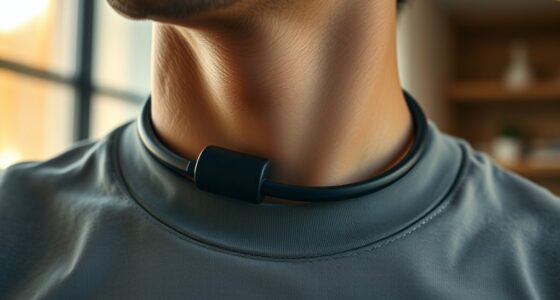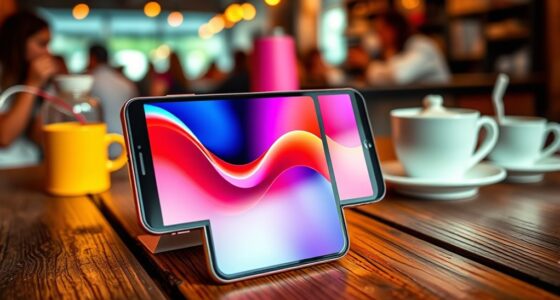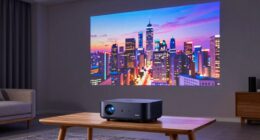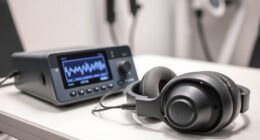As we explore the world of assistive listening devices for educational settings, it is evident that the landscape is as varied as an unraveling tapestry of colors.
From the whispering wonders of Personal FM Systems to the seamless integration of Bluetooth Receivers, each device holds a promise of enhancing educational experiences for students with hearing challenges.
With advancements in technology and a focus on accessibility, the possibilities seem endless.
So, let's explore together how these devices are revolutionizing the way we perceive classroom communication.
Key Takeaways
- Personal FM Systems enhance auditory clarity in challenging environments.
- Bluetooth Receivers provide wireless audio connectivity for students with hearing impairments.
- Induction Loop Systems reduce background noise effectively for inclusive learning.
- Soundfield Systems improve speech intelligibility and learning outcomes in classrooms.
Personal FM Systems
Personal FM systems, like the Williams Sound PFM PRO RCH, significantly enhance auditory clarity and comprehension in challenging environments by directly delivering superior audio to the ear. These devices are invaluable in settings such as classrooms, workplaces, and homes where background noise and distance can impede effective communication. The ability of Personal FM systems to overcome these obstacles ensures an improved listening experience for individuals with hearing impairments.
One notable advantage of Personal FM systems is their versatility. They're adept at delivering clear sound directly to the listener, making them indispensable tools for individuals seeking auditory support in various situations. Moreover, the rechargeable options available provide convenience and reliability, guaranteeing continuous assistance for those with hearing loss.
In addition to their practical benefits, Personal FM systems play a crucial role in ensuring legislative compliance regarding accessibility for individuals with hearing impairments. By offering superior audio quality and tailored support, these devices not only enhance the overall auditory experience but also promote inclusivity and equal access to information.
Bluetooth Receivers

Bluetooth receivers revolutionize classroom accessibility by providing seamless wireless audio connectivity for students with hearing impairments. These devices enhance the learning experience by delivering clear and personalized sound to students facing hearing challenges.
Here are three key features of Bluetooth receivers:
- Wireless Connectivity: Bluetooth receivers offer wireless audio connectivity, allowing students to pair them with smartphones, tablets, or computers. This wireless connection enables students to stream audio directly to their hearing aids or headphones, eliminating the need for cumbersome wired setups.
- Convenience and Flexibility: Bluetooth receivers provide convenience and flexibility by allowing students to access educational content without being restricted by wired connections. This feature enhances the mobility of students within the classroom, enabling them to move around freely while staying connected to the audio source.
- Enhanced Features: Some Bluetooth receivers come equipped with long battery life, adjustable volume settings, and compatibility with a variety of devices. These additional features cater to the diverse needs of students with hearing impairments, providing them with a customizable listening experience tailored to their preferences.
Induction Loop Systems
Induction loop systems, utilizing electromagnetic fields, offer a direct sound transmission method to hearing aids or cochlear implants. These systems generate a magnetic field that T-coil equipped devices can capture, effectively reducing background noise.
Their affordability and inclusive nature make them a prevalent choice in educational settings, ensuring improved auditory experiences for individuals with hearing impairments.
Loop System Basics
Utilizing a wire loop system that emits a magnetic field, hearing loop systems, also referred to as induction loop systems, wirelessly deliver audio directly to hearing aids with telecoils. These systems are beneficial for individuals with hearing loss, offering enhanced speech clarity and reduced background noise in various settings.
Here are three key features of induction loop systems:
- Wire Loop Installation: A wire loop is installed around the perimeter of a room, creating a magnetic field that transmits audio signals.
- Telecoil Compatibility: Hearing aid users switch their devices to telecoil mode to receive the audio signal wirelessly from the loop system.
- Improved Accessibility: Induction loop systems are commonly utilized in classrooms, theaters, churches, and public spaces to provide clear audio to individuals wearing hearing aids.
Installation Process Overview
When setting up an induction loop system for classroom use, the initial step involves strategically laying a loop wire around the perimeter of the designated space. This wire creates an electromagnetic field that transmits audio signals directly to compatible hearing aids with telecoils. The loop wire then connects to an amplifier, which sends sound signals through the loop. This setup enables students with telecoil-equipped hearing aids to receive clear sound without background noise, improving their listening experience. The installation process for induction loop systems is crucial in ensuring that students with hearing impairments can benefit from personalized audio directly to their devices.
| Installation Steps | Description |
|---|---|
| Lay loop wire | Strategically position wire around the room perimeter. |
| Connect to amplifier | Link the loop wire to an amplifier for signal transmission. |
| Test system | Ensure proper functionality and sound clarity. |
Benefits for Students
Students benefit significantly from utilizing induction loop systems in classrooms. They experience improved speech understanding, heightened focus, and enhanced learning outcomes. Induction loop systems enhance the educational experience for students with hearing aids by:
- Providing clear, customized sound directly to their hearing devices, eliminating background noise and ensuring optimal auditory perception.
- Increasing their ability to concentrate on classroom lectures and discussions, leading to improved information retention and academic performance.
- Aligning with ADA standards for equal access to education, ensuring that all students, including those with hearing loss, have the opportunity to fully engage in the learning process.
Infrared Systems

Infrared systems, such as the IRT2 System, excel in providing clear sound transmission, ensuring students with hearing loss can effectively follow classroom discussions.
The easy setup process of these systems facilitates quick integration into educational environments, enhancing accessibility for all students.
Additionally, their wide coverage range makes them suitable for classrooms of varying sizes, offering consistent sound quality across different listening areas.
Clear Sound Transmission
How does the utilization of infrared light enhance sound transmission clarity in educational settings?
Infrared systems excel at providing crystal-clear sound transmission directly to users' receivers. Here are three key ways in which this technology achieves such clarity:
- Direct Transmission: Infrared systems use light to carry the audio signal, ensuring that the sound reaches the intended receivers without interference or degradation.
- Background Noise Reduction: By utilizing infrared light, these systems minimize the impact of background noise, allowing users to focus on the intended audio without distractions.
- Privacy and Security: Infrared technology offers a secure method of transmitting audio, ensuring that the signal remains private and doesn't interfere with other electronic devices.
Easy Setup Process
When setting up an infrared system for classroom use, careful positioning of transmitters and connection of receivers to hearing aids or headphones are essential steps to ensure optimal sound coverage and clarity.
The setup process involves placing the transmitters strategically to cover the entire classroom space effectively. Ensuring a direct line of sight between the transmitters and receivers is crucial for seamless signal transmission.
Additionally, connecting the receivers to students' hearing aids or headphones should be straightforward and well-documented in the system's user manual. With the user-friendly design of infrared systems, the setup can typically be completed without extensive technical expertise, making it convenient for teachers and school staff to implement quickly and efficiently.
Wide Coverage Range
For classrooms and auditoriums requiring expansive sound coverage, utilizing infrared systems offers a solution with wide coverage ranges up to 28,000 square feet. Infrared systems have specific features that make them beneficial for educational settings:
- Clear Sound Delivery: Infrared systems use invisible light to transmit audio signals, reducing interference and ensuring clear sound delivery throughout the designated area.
- Enhanced Privacy: The signal of infrared systems doesn't pass through walls, providing secure and confidential communication during educational sessions.
- Reliable Performance: Immune to radio frequency interference, infrared technology offers a reliable choice for consistent audio transmission in learning environments, ensuring uninterrupted communication for all users.
Soundfield Systems
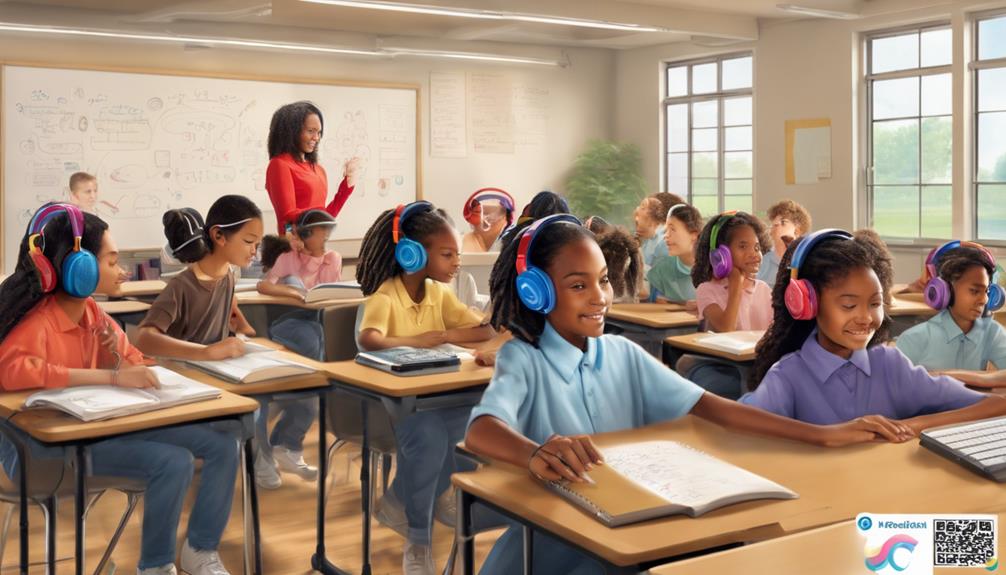
Soundfield systems, utilizing strategically positioned microphones and speakers, effectively distribute the teacher's voice throughout the classroom to enhance speech intelligibility and learning outcomes. These systems improve students' ability to hear the teacher clearly by overcoming background noise and ensuring a consistent sound level regardless of their seating arrangement. Research indicates that soundfield systems can boost students' attention, participation, and comprehension in educational settings. By reducing the strain on students' hearing, these systems create an inclusive learning environment that supports students with hearing challenges.
| Pros | Cons |
|---|---|
| Enhances speech intelligibility | Initial setup cost may be high |
| Reduces strain on students' hearing | Requires maintenance and calibration |
| Improves learning outcomes | Speaker placement may need adjustment |
| Overcomes background noise | Integration with existing technology |
| Supports students with hearing challenges | Training for teachers may be necessary |
Wireless Microphone Systems
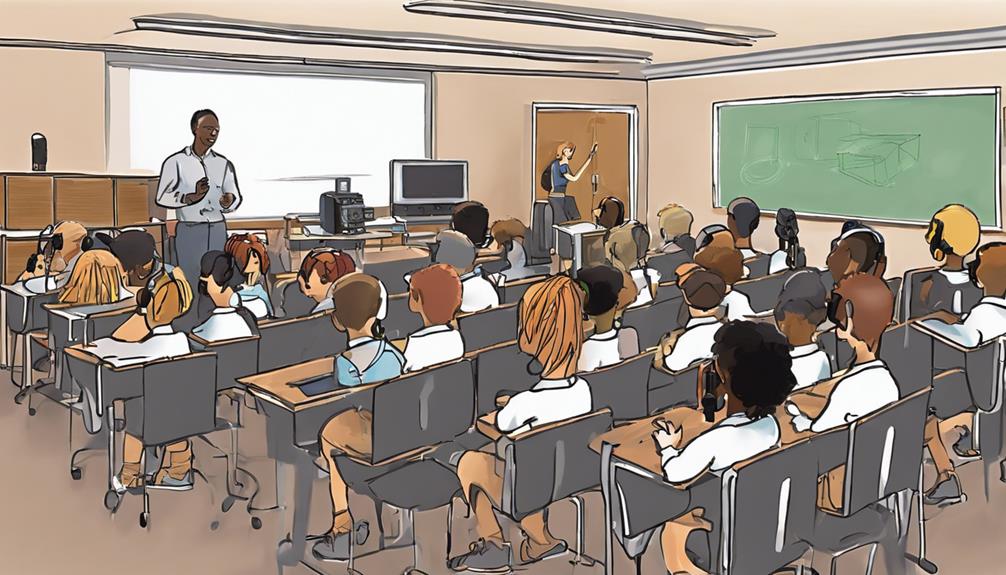
Wireless microphone systems, such as the Anchor Audio AL-9000, offer a broad range of coverage and exceptional sound quality. These systems allow for clear sound projection and provide unlimited headsets with loud and clear audio, making them ideal for classroom settings.
Configurable listening groups within the same classroom can be achieved with the AL-9000 system, enhancing accessibility and engagement for both teachers and students.
Range of Coverage
When selecting a wireless microphone system for classroom use, it's crucial to consider the range of coverage provided, which can vary from 100 feet up to 1,000 feet depending on the model. Here are some key points to keep in mind when evaluating the range of coverage for wireless microphone systems:
- Coverage Range: Wireless microphone systems typically offer coverage ranges from 100 feet to 300 feet, with some models extending up to 1,000 feet for larger classroom setups.
- Adjustable Transmission Power: Different systems provide adjustable transmission power to optimize coverage in classrooms of varying sizes.
- Consider Classroom Size: It's essential to consider the size of the classroom and the number of students when selecting a wireless microphone system to ensure all listeners receive clear audio signals from the teacher or speaker.
Sound Quality
Enhancing the classroom experience, wireless microphone systems seamlessly deliver clear sound transmission directly to students' ears, optimizing auditory comprehension and focus. These systems excel at providing crystal-clear sound by overcoming background noise and ensuring the speaker's voice is heard distinctly.
Students benefit significantly from this enhanced sound quality, experiencing improved comprehension and concentration. Moreover, teachers find that using wireless microphone systems helps them maintain vocal clarity and reduces vocal strain during instruction.
The advanced technology embedded in these systems plays a crucial role in facilitating effective communication and learning in noisy classroom environments. In essence, the clear sound transmission offered by wireless microphone systems elevates the educational experience for both students and educators, fostering an environment conducive to learning.
Remote Microphone Systems

Utilizing advanced technology, remote microphone systems such as the Roger Touchscreen Mic offer a solution for clear communication in noisy classroom environments. These systems are designed to reduce background noise and deliver the speaker's voice directly to students, ensuring optimal auditory access. Here are three key features of remote microphone systems that enhance the classroom experience:
- Roger Pass-around Mic: This innovative tool promotes student engagement by facilitating easy sharing during class discussions. With the ability to pass the microphone around, all students can participate actively, fostering a collaborative learning environment.
- Enhanced Speech Recognition: Roger's technology not only amplifies the speaker's voice but also enhances speech recognition for students. By improving the clarity of speech signals, these systems provide better learning opportunities for all students, especially those with hearing impairments.
- Adaptive Volume Adjustment: Remote microphone systems come equipped with adaptive volume adjustment features that help maintain consistent sound levels. This contributes to improved focus and attention among students, creating an ideal setting for effective learning and communication.
Hearing Amplifiers

Hearing amplifiers, essential devices for individuals with mild to moderate hearing loss, enhance the volume and clarity of environmental sounds, speech, and other audio inputs. These personal sound amplification devices are tailored to improve sound quality for users, offering a discreet and cost-effective alternative to traditional hearing aids.
By amplifying various sounds in different settings such as classrooms or social gatherings, hearing amplifiers help individuals with hearing difficulties to engage more effectively in conversations and activities. Unlike bulkier hearing aids, these devices are smaller and less conspicuous, making them a popular choice among those seeking inconspicuous hearing assistance.
Additionally, hearing amplifiers provide a practical solution for people who don't yet require full-fledged hearing aids but still benefit from enhanced sound amplification. Their versatility and affordability make them a valuable tool for improving communication and overall hearing experiences for individuals with mild to moderate hearing loss.
Classroom Audio Distribution Systems
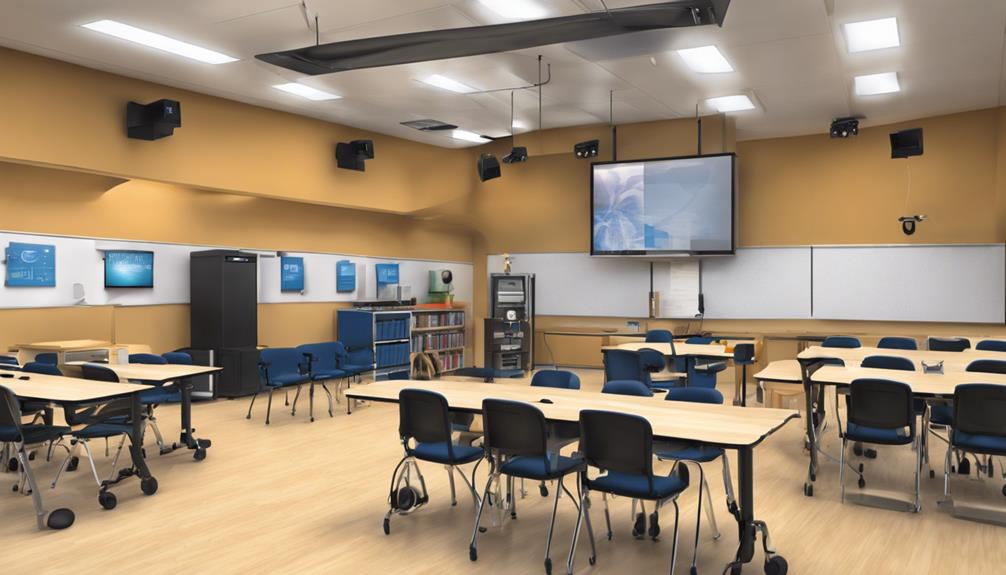
In the realm of assistive technology for individuals with hearing difficulties, the adoption of classroom audio distribution systems like FM, infrared, and loop systems has significantly improved auditory access and learning environments. These systems offer tailored solutions to overcome challenges such as background noise and distance, ensuring compliance with legislation and enhancing audio access for students with hearing loss. Here are three key listening solutions:
- Portable Systems: Options like ListenTALK and ADA kits provide on-demand assistive listening solutions suitable for rooms with capacities of up to 75 individuals. These portable systems offer flexibility and ease of use for various classroom settings.
- Value Packages: Affordable setups like the LP-4VP-072 and PPA VP 37-00 packages cater to basic assistive listening needs in diverse educational environments. These packages include all the necessary equipment for enhanced listening experiences without breaking the budget.
- Enhanced Classroom Accessibility: Classroom audio distribution systems contribute to creating inclusive learning environments by providing students with hearing difficulties equal access to educational content, fostering engagement and participation.
Assistive Listening Device Accessories
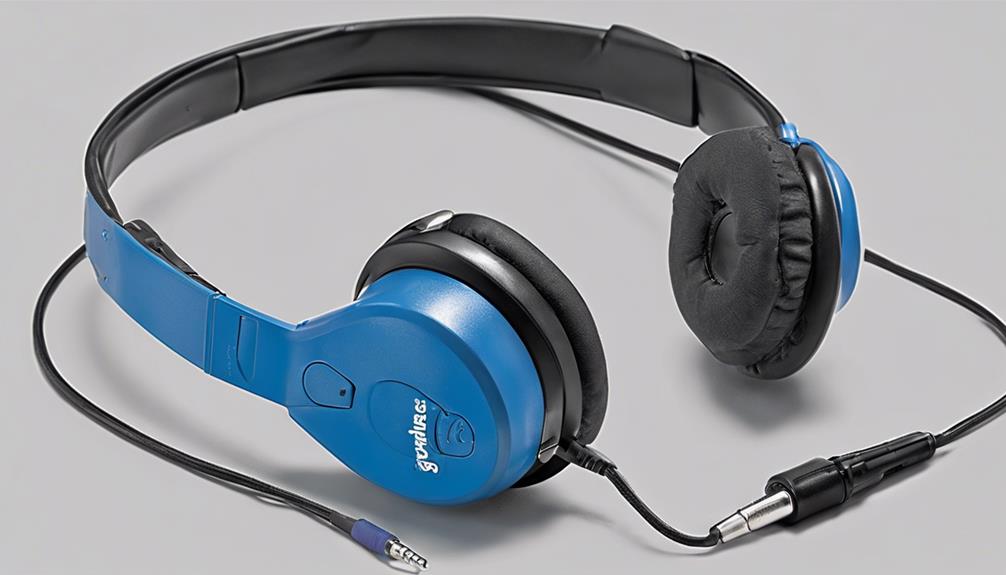
Assistive listening device accessories play a crucial role in enhancing the functionality and performance of assistive technology solutions for individuals with hearing difficulties. These accessories, such as microphones, charging racks, and repeaters, are designed to optimize the usage of assistive listening devices like hearing aids. Here are some key accessories that can benefit classroom settings:
| Accessory | Description | Benefit |
|---|---|---|
| Roger™ Touchscreen Mic | Allows for clear communication and student engagement | Enhances classroom interaction |
| Pass-around Mic | Facilitates communication among students and teachers | Encourages participation and collaboration |
| Roger™ Multimedia Hub | Enables audio mixing for varied sound sources | Enhances audio customization and flexibility |
| WallPilot | Facilitates automatic connections between devices | Streamlines setup and ensures seamless connectivity |
These accessories like the Charging Rack ensure that assistive listening devices are always ready for use, while the Roger™ Repeater extends the audio range for optimal coverage in educational settings. By incorporating these accessories, individuals with hearing difficulties can experience improved auditory support in classroom environments.
Frequently Asked Questions
What Is the Most Common Assistive Listening Device for a School Setting?
The most common assistive listening device for a school setting is the FM system. It's widely used due to its effectiveness in overcoming background noise and distance challenges.
These systems deliver superior audio directly to the ear, ensuring clear communication in classrooms. FM systems are rechargeable and ideal for enhancing the listening experience for students and teachers.
They help students maintain focus, improve comprehension, and actively engage in educational activities.
What Are the Four Major Types of Assistive Listening Devices?
We've identified the four main types of assistive listening devices: personal FM systems, infrared systems, loop systems, and Bluetooth technology. Each of these technologies serves the purpose of transmitting sound to individuals with hearing impairments.
Personal FM systems use transmitters and receivers for direct audio delivery. Infrared systems utilize light waves for transmission. Loop systems employ electromagnetic fields to send signals to hearing aids or implants. Bluetooth permits wireless streaming to compatible devices.
What Devices Are Used in the Classroom for Hearing Impaired People?
When addressing the needs of hearing-impaired individuals in classrooms, we rely on a variety of devices. These include:
- Neckloops for wireless Bluetooth connectivity and amplification
- Signaling systems for event alerts
- Adaptive telephone devices like captioned phones for communication
- Livescribe Pens for note digitization and audio recording
- Ring signaling devices
Each device plays a crucial role in enhancing the educational experience for those with hearing loss.
What Is the FM System Used in the Classroom?
When used in the classroom, the FM system comprises a transmitter worn by the teacher and a receiver by the student with hearing impairment. It helps by overcoming background noise and distance, delivering the teacher's voice directly to the student's ear.
This technology enhances auditory access, ensuring clear communication and understanding. FM systems are widely employed in educational settings, providing a focused auditory experience that benefits students by improving learning outcomes.
Conclusion
In conclusion, these top assistive listening devices for classroom use are like magical wands that wave away the barriers to communication for students with hearing impairments.
With their ability to deliver crystal-clear audio directly to the ear, they transform noisy classrooms into serene learning environments where every word is heard with precision.
These devices truly work wonders in creating an inclusive and accessible educational experience for all students.




